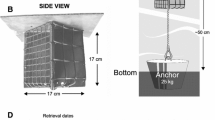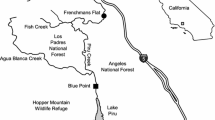Summary
Speculation about the effects of disturbance in marine benthic communities is often based on competition theory. Disturbances are thought to “provision” numerically depleted or competitively inferior species with resources associated with open substrate. However, disturbances that remove entire assemblages of sessile species also alter trophic structure, and thereby, influence the outcome of predator/prey relations. Aspects of community structure may be determined by patterns of disturbance and predation.
The influence of disturbance and predation on the distribution and seasonality of blooms of ephemeral algae and associated Diptera was investigated with field experiments at several rocky beaches in central California. Blooms of ephemeral algae developed on high intertidal rock faces that were subject to severe seasonal disturbances caused by shifting sediment. These were subsequently colonized by the herbivorous larvae of several Diptera species for predictable periods each year. Other areas, without blooms, were not so disturbed.
Experiments were done to determine if seasonal blooms were caused by seasonal disturbances that remove predators which otherwise might prevent the establishment of the Diptera/algae assemblage. The predators were crabs and limpets which eat both algae and larvae while foraging. Blooms of algae and larvae did not develop when limpets were transplanted to disturbed areas in periods between disturbances. Adjacent control areas did support blooms. Transplanted limpets did not survive periods of burial. When both limpets and crabs were excluded from treatment plots in undisturbed areas, blooms developed where they would not otherwise have occurred; controls remaied unchanged. Crabs and limpets differed in their effects on this assemblage. Crabs recruited quickly to the site of a bloom, but did not crop algal cover as closely, nor decrease larval density as much as the slowly recruiting limpets.
The results suggest that disturbances favor blooms of some species by reducing predation. Severe localized disturbances increased the variability of the upper shore community by creating a patchwork of differing predator/prey abundances.
Similar content being viewed by others
References
Abbott IA, Hollenberg GJ (1976) Marine algae of California. Stanford University Press, Stanford
Aleem AA (1950) Distribution and ecology of British marine littoral diatoms. J. of Ecol 38:75–106
Bascom W (1964) Waves and beaches: The dynamics of the ocean surface. Anchor, Doubleday, New York
Behrens S (1971) The distribution and abundance of the intertidal prosobranch, Littorina scutulata (Gould 1899) and L. sitkana (Philippi 1845). M.S. thesis, Univ of British Columbia, Vancouver
Castenholz RW (1961) The effect of grazing on marine littoral diatom populations. Ecol 42:783–794
Choat JH (1977) The influence of sessile organisms on the population biology of Acimeid limpets. J Exp Mar Biol Ecol 26:1–26
Connell JH (1971) On the rote of natural enemies in preventing competitive exclusion in some marine animals and rainforest trees. In PJ den Boer and GR Gradwell editors, Dynamics of Populations, Center for Agricultural Publications and Documentations, Wageningen, Netherlands
Connell JH (1973) Population ecology of reef building corals, pp 205–245. In OA Jones and R. Endean, editors, Biology and geology of coral reefs, Vol 2, Biology 1. Academic Press, New York
Connell JH (1978) Diversity in tropical rain forests and coral reefs. Science 199:1302–1310
Conway E, Mumford TF Jr, Scagel RF (1976) The genus Porphyra in British Columbia and Washington, Syesis: 185–244
Cubit J (1975) Interactions of seasonally changing physical factors and grazing affecting high intertidal communities on a rocky shore. Ph.D. thesis, Univ of Oregon, Eugene
Cushing DH (1975) Marine Ecology and Fisheries. Cambridge University Press, London
Daly MA, Mathieson AC (1977) The effect of sand movement on intertidal seaweeds and selected invertebrates at Bound Rock, New Hampshire Mar Biol 43:45–55
Dayton PK (1970) Competition, predation and community structure: the allocation and subsequent utilization of space in a rocky intertidal community. Ph.D. thesis. Univ of Washington, Seattle
Dayton PK (1971) Competition, disturbance and community organization: the provision and subsequent use of the rocky intertidal. Ecol Monogr 41:351–389
Dayton PK, Robilliard GA, Paine RT, Dayton ZB (1970) Benthic faunal zonation as a result of anchor ice at McMurdo Sound, Antarctica. In: Holdgate MW (ed) Antarctic Ecology, Academic Press, London
Frank PW (1965) The biodemography of an intertidal snail population. Ecol 46:831–844
Glynn PW (1976) Some physical and biological determinants of coral community structure in the Eastern Pacific. Ecol Monogr 46:431–456
Grigg RW, Maragos GE (1974) Diversity and colonization of Hawaiian coral reefs. Ecol 55:387
Hiatt RM (1948) The biology of the lined shore crab, Pachygrapsus crassipes. Pacific Science 2:135–213
Hutchinson GE (1951) Copepodology for the ornithologist. Ecol 32:571–577
Johnson DS, Skutch AF (1928) Littoral vegetation on a headland of Mt. Desert Island, Maine. I. Submersible or strictly littoral vegetation. Ecol 9:188–215
Johnstone J (1908) Conditions of Life in the Sea. Cambridge Univ Press, London
Kitching JA (1937) Studies in sublittoral ecology. II. Recolonization at the upper margin of the sublittoral region; with a note on the denudation of Laminaria forests by storms. J of Ecol 25:482–495
Komar PD (1976) Beach Processes and Sedimentation. Prentice-Hall Inc. New Jersey
Lawson GW (1957) Seasonal variation of the intertidal zonation on the coast of Ghana in relation to tidal factors. J Ecol 45:831–860
Leonard SD (1972) The natural history of Paraclunio alaskensis and Paraclunio trilobatus (Diptera, Chironomidae), two intertidal flies. M.S. thesis Humbolt State College, Humbolt
Levin S, Paine RT (1974) Disturbance, patch formation, and community structure. Proc Nat Acad Sci Vol 71, pp 2744–2747
Loya Y (1976) Recolonization of Red Sea corals affected by natural catastrophies and man-made perturbations. Ecol 57:278–289
Lubchenco J (1980) Algal zonation in the New England rocky intertidal community: an experimental analysis. Ecol 61:333–344
Lubchenco J, Cubit J (1980) Heteromorphic life histories of certain marine algae as adaptations to variations in herbivory. Ecol 61:676–687
Menge BA (1978) Predation intensity in a rocky intertidal community: relation between predator foraging activity and environmental harshness. Oecol 34:1–16
Menge BA, Sutherland JP (1976) Species diversity gradients: synthesis of the roles of predation, competition and temporal heterogeneity. Amer Nat 110:351–369
Morely RH, Ring RA (1972) Intertital Chironomidae (diptera) of British Columbia: II. Life history and population dynamics. Can Ent 104:1099–1121
Nicotri ME (1974) Resource partitioning, grazing activities, and influence on the microflora by intertidal limpets. Ph.D. thesis. Univ of Washington, Seattle
Paine RT, Levin SA (1981) Intertidal landscapes: disturbance and the dynamics of pattern. Ecol Monogr 51:145–173
Ricketts RF, Calvin J (1972) Between Pacific Tides. 4th ed. J Hedgpeth (ed). Stanford University Press
Rützler K (1970) Spatial competition among Porifera: solution by epizoism. Oecol 5:85–95
Robles CD (1979) Disturbance and the interactions of herbivorous diptera with their resources, competitors, and predators on rocky shores. Ph.D. thesis. Univ of California, Berkeley
Robles CD, Cubit JD (1981) Influence of biotic factors in an upper intertidal community: effects of grazing diptera larvae on algae. Ecol 62:1536–1547
Saunders LG (1928) Some marine insects of the Pacific Coast of Canada. Ann Ent Soc Amer 21:521–531
Sommerfeld MR, Nichols HW (1970) Developmental and cytological studies of Bangia fuscopurpurea in culture. Amer J Bot 57:640–648
Sousa WP (1979) Disturbance in marine intertidal boulder fields: the non-equilibrium maintenance of species diversity. Ecol 60:1225–1239
Southward AJ (1956) The population balance between limpets and seaweeds on wave-beaten rocky shores. Rept Mar Biol Sta Port Evin 68:20–29
Southward AJ (1964) Limpet grazing and the control of vegetation on rocky shores. In: Crisp DJ (ed) Grazing in terrestrial and marine environments. Blackwell, Oxford
Stoddart DR (1972) Catastrophic damage to coral reef communities by earthquake. Nature 239:51–52
Woodin SA (1978) Refuges, disturbance, and community structure: a marine soft-bottom example. Ecol 59:274–284
Author information
Authors and Affiliations
Rights and permissions
About this article
Cite this article
Robles, C. Disturbance and predation in an assemblage of herbivorous Diptera and algae on rocky shores. Oecologia 54, 23–31 (1982). https://doi.org/10.1007/BF00541103
Received:
Issue Date:
DOI: https://doi.org/10.1007/BF00541103




